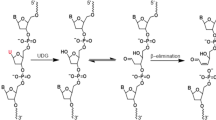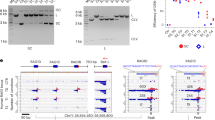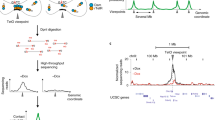Abstract
PHYSICAL mapping of chromosomes would be facilitated by methods of breaking large DNA into manageable fragments, or cutting uniquely at genetic markers of interest. Key issues in the design of sequence-specific DNA cleaving reagents are the specificity of binding, the generalizability of the recognition motif, and the cleavage yield. Oligonucleotide-directed triple helix for-mation is a generalizable motif for specific binding to sequences longer than 12 base pairs within DNA of high complexity1–3. Studies with plasmid DNA show that triple helix formation can limit the operational specificity of restriction enzymes to endonu-clease recognition sequences that overlap oligonucleotide-binding sites4,5. Triple helix formation, followed by methylase protection, triple helix-disruption, and restriction endonuclease digestion produces near quantitative cleavage at the single overlapping triple helix–endonuclease site4,5. As a demonstration that this technique may be applicable to the orchestrated cleavage of large genomic DNA, we report the near quantitative single-site enzymatic cleavage of the Saccharomyces cerevisiae genome mediated by triple helix formation. The 340-kilobase yeast chromosome HI was cut uniquely at an overlapping homopurine–Ec0RI target site 27 base pairs long to produce two expected cleavage products of 110 and 230 kilobases. No cleavage of any other chromosome was detected. The potential generalizability of this technique, which is capable of near quantitative cleavage at a single site in at least 14 megabase pairs of DNA, could enable selected regions of chromosomal DNA to be isolated without extensive screening of genomic libraries.
This is a preview of subscription content, access via your institution
Access options
Subscribe to this journal
Receive 51 print issues and online access
$199.00 per year
only $3.90 per issue
Buy this article
- Purchase on Springer Link
- Instant access to full article PDF
Prices may be subject to local taxes which are calculated during checkout
Similar content being viewed by others
References
Moser, H. E. & Dervan, P. B. Science 238, 645–650 (1987).
Strobel, S. A., Moser, H. E. & Dervan, P. B. J. Am. chem. Soc. 110, 7927–7929 (1988).
Strobel, S. A. & Dervan, P. B. Science 249, 73–75 (1990).
Maher, L. J., Wold, B. & Dervan, P. B. Science 245, 725–730 (1989).
Hanvey, J. C., Shimizu, M. & Wells, R. D. Nucleic Acids Res. 18, 157–161 (1990).
Barlow, D. P. & Lehrach, H. Trends Genet. 3, 167–171 (1987).
Wenzlau, J. M., Saldanha, R. J., Butow, R. A. & Perlman, P. S. Cell 56, 421–430 (1989).
Delahodde, A. et al. Cell 56, 431–441 (1989).
Patel, Y., Van Cott, E., Wilson, G. G. & McClelland, M. Nucleic Acids Res. 18, 1603–1607 (1990).
Weil, M. D. & McClelland, M. Proc. natn Acad. Sci. U.S.A. 86, 51–55 (1989).
Koob. M., Grimes, E. & Szybalski, W. Science 241, 1084–1086 (1988).
Koob, M. & Szybalski, W. Science 250, 271–273 (1990).
Praseuth, D. et al. Proc. natn Acad. Sci. U.S.A. 85, 1349–1353 (1988).
Lyamichev, V. I. et al. Nucleic Acids Res. 16, 2165–2178 (1988).
Felsenfeld, G., Davies, D. R. & Rich, A. J. Am. chem. Soc. 79, 2023–2024 (1957).
Lipsett, M. N. J. biol. Chem. 239, 1256–1260 (1964).
Rajagopal, P. & Feigon, J. Nature 339, 637–640 (1989).
Povsic, T. J. & Dervan, P. B. J. Am. chem. Soc. 111, 3059–3061 (1989).
Griffin, L. C. & Dervan, P. B. Science 245, 967–971 (1989).
Horne, D. A. & Dervan, P. B. J. Am. chem. Soc. 112, 2435–2437 (1990).
Andreadis, A., Hsu, Y. P., Kohlhaw, G. B. & Schimmel, P. Cell 31, 319–325 (1982).
Mortimer, R. K. & Schild, D. Microbiol. Rev. 49, 181–212 (1985).
Carle, G. F. & Olson, M. V. Proc. natn Acad. Sci. U.S.A. 82, 3756–3760 (1985).
Schwartz, D. C. & Cantor, C. R. Cell 37, 67–75 (1984).
Carle, G. F. & Olson, M. V. Nucleic Acids Res. 12, 5647–5664 (1984).
Keesey, J. K., Bigelis, R. & Fink, G. R. J. biol. Chem. 254, 7427–7433 (1979).
Maher, L. J., Dervan, P. B. & Wold, B. Biochemistry 29, 8820–8826 (1990).
Author information
Authors and Affiliations
Rights and permissions
About this article
Cite this article
Strobel, S., Dervan, P. Single-site enzymatic cleavage of yeast genomic DNA mediated by triple helix formation. Nature 350, 172–174 (1991). https://doi.org/10.1038/350172a0
Received:
Accepted:
Issue Date:
DOI: https://doi.org/10.1038/350172a0
Comments
By submitting a comment you agree to abide by our Terms and Community Guidelines. If you find something abusive or that does not comply with our terms or guidelines please flag it as inappropriate.



